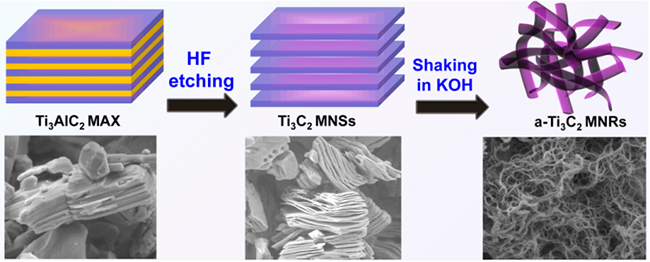As post-lithium ion batteries, both sodium ion batteries (SIBs) and potassium ion batteries (PIBs) possess great potential for large scale energy storage. However, the improvements of both SIBs and PIBs for practical applications are facing great challenges in the development of high-performance electrode materials.
MXenes, a large family of 2D transition metal carbides and carbonitrides have gained widespread interest as emerging potential host materials for metal (Li, Na, K, Mg) ion batteries. It's due to their unique morphology, high theoretical capacity which are 447.8, 351.8, 191.8 mAh/g for Li, Na, K on Ti3C2, respectively, and flexible interlayer space capable of handling high rate capability.
However, multilayer MXene nanosheets with small interlayer space for large ionic radius of Na+ and K+, usually show limited reversible capacities as well as poor cyclic stability. Therefore, rationally designing novel MXene based nanostructures with suitable interlayer spacing and stable structure, using innovative synthesis strategies, is of great significance for improving sodium and potassium storage kinetics of SIBs and PIBs.

Alkalized Ti3C2 (a-Ti3C2) MXene nanoribbons synthesized by continuous shaking treatment of pristine Ti3C2 MXene in aqueous KOH solution.
Scientists WU Zhongshuai and BAO Xinhe et al. at Dalian Institute of Chemical Physics (DICP) of the Chinese Academy of Sciences (CAS) collaborated with WANG Xiaohui from Institute of Metal Research of CAS, developed alkalized Ti3C2 (a-Ti3C2) MXene nanoribbons with expanded interlayer spacing for high-capacity SIBs and PIBs. This work has been published online in Nano Energy (DOI: 10.1016/j.nanoen.2017.08.002).
a-Ti3C2 nanoribbons were successfully synthesized by continuous shaking treatment of pristine Ti3C2 MXene in aqueous KOH solution. Due to the expanded interlayer spacing of a-Ti3C2, the narrow widths of nanoribbons as well as three-dimensional interconnected porous frameworks enhanced the ion reaction kinetics and improved the structure stability. The resulting a-Ti3C2 anodes showed excellent sodium/potassium storage performance. For example, high reversible capacities of 168 and 136 mAh/g at 20 mAh/g,and 84 and 78 mAh/g at 200 mAh/g were obtained for SIBs and PIBs, respectively.
Notably, a-Ti3C2 possessed outstanding long-term cyclability at high current density of 200 mAh/g, delivering a capacity of ~ 50 mAh/g for SIBs and ~42 mAh/g for PIBs after 500 cycles. It outperformed the reported MXene based anodes for SIBs and PIBs.
Moreover, this alkalization strategy could be extended as a universal approach for fabricating various alkalized MXene-based frameworks derived from a large family of MAX phases for numerous applications, such as catalysis, energy storage and conversion.
This work was supported by National Key R&D Program of China, National Natural Science Foundation of China, Natural Science Foundation of Liaoning Province, and DICP and China Postdoctoral Science Foundation. (Text and Image by DONG Yanfeng and ZHAO Xuejun)